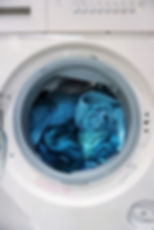Even 60-degree washes still contain germs
- Jenner Nex
- May 2
- 4 min read
Clothes are often not hygienically clean with normal washing machines
Nothing like clean: Despite supposedly hygienic wash programs, normal washing machines do not remove all germs, as a study shows. According to the study, bacteria often survive even 60-degree washes and settle in clothing and the machine, including pathogens and antibiotic-resistant germs. This could contribute to the spread of infections. This is particularly problematic when the work clothes of nurses, caregivers, and other healthcare workers are washed in such household machines.

If washing machines are not cleaned properly or regularly enough, they can become veritable germ breeding grounds. For example, researchers have discovered more than 200 species of bacteria in machines in German households, including pathogens. These microbes also settle in freshly washed clothing and can pose a health risk to the wearer.
This is particularly problematic when it comes to the work clothes of nurses, caregivers, doctors, and other healthcare workers. These textiles can be contaminated with pathogens and multi-drug-resistant hospital germs, which can spread them further. Although washing regulations apply, many employees in the British and US healthcare systems wash their work clothes at home in standard washing machines.
How hygienic are washing machines?
But can regular washing machines remove these dangerous germs? Or do bacteria remain in the clothing or the washing machine? Researchers led by Caroline Cayrou from De Montfort University in Leicester have now investigated this question. To do so, they washed clothes in six different models of household washing machines. They intentionally contaminated the fabric samples with the intestinal bacteria Enterococcus faecium, which can cause various infections.

For their test washes, the researchers used various detergents and two programs: a quick wash cycle and a normal cleaning program, each at 60 degrees Celsius. They then analyzed whether Enterococcus bacteria were still present in the clothing.
The team also took swab samples from these and six other washing machines for biofilms – in the detergent drawer and under the rubber seal of the drum near the door. Cayrou and her colleagues used DNA sequencing to examine which types of bacteria were present in these samples.
Germ-contaminated even after washing
The washing experiment revealed that, with the standard program, two out of six washing machines did not produce sufficiently disinfected fabric samples. Enterococcus bacteria were still present in the textiles. The same was true for three out of six machines using the quick wash cycle.
The reason: The target temperature of 60 degrees Celsius was not reached and/or not maintained long enough in the machines, as a program check revealed. "Even if healthcare workers believe they are disinfecting their uniforms [as required] for ten minutes at 60 degrees Celsius, there is a high probability that the device they are using is not performing as expected," the researchers report.
Water hardness as a hygiene factor
According to the study, about half of all standard washing machines are not suitable for removing hospital germs from staff clothing according to current regulations. Household textiles such as towels, bed linen, etc., which are often washed at 60 degrees, are also not adequately disinfected in such washing machines.
However, not only the washing machine and the program play an important role in hygiene, but also the location and detergent dosage. "Water hardness can impair the effectiveness of the detergent," the team notes. Therefore, in hard water, more detergent may be needed to kill the germs.

Biofilms in washing machines contain pathogens
The analysis of the swabs also revealed that germs had accumulated in eight out of twelve washing machines. According to the study, bacteria often still grow in the detergent drawer and the rubber seal, even after 60-degree washes. Even if the drum reaches a sufficiently high temperature to disinfect the drawer and the clothes, this apparently doesn't apply to all parts of the machine.
Among the microbes found were bacteria that can cause disease—such as Mycobacteria, Pseudomonas, or Acinetobacter species—and some that carry antibiotic resistance genes and therefore cannot be treated with antibiotics, the team found.
Machine Washing Can Promote Resistance
Some of the bacteria, including Staphylococcus aureus and Klebsiella pneumoniae, had also developed resistance to detergents. This, in turn, increased their resistance to certain antibiotics or even led to the emergence of new resistances, as further tests revealed. "In one remarkable case, a previously antibiotic-sensitive strain of Staphylococcus aureus developed antibiotic resistance and essentially became MRSA without ever being exposed to antibiotics," reports senior author Katie Laird.
The researchers conclude that the biofilms in washing machines are an environment that promotes antibiotic resistance. According to this study, many household washing machines are not only unsuitable for decontaminating clothes, but they even actively contribute to the development and spread of infections and antibiotic resistance, the researchers conclude.
How do clothes really get clean?
"If we are serious about reducing the transmission of infectious diseases through textiles and combating antibiotic resistance, we need to rethink how we wash our healthcare workers' clothing," write Cayrou and her colleagues. They believe that laundry guidelines for healthcare workers need to be revised to control the spread of pathogens and improve patient safety.
The guidelines could, for example, require that home washing machines use higher-temperature programs with longer cycle times and be cleaned more frequently to prevent germs from accumulating. These tips could also be applied to personal laundry.
Alternatively, work clothes could be washed in industrial washing machines in healthcare facilities. This is already the case in Germany. "The UK is the only country in Europe where nurses' uniforms are regularly washed at home," explains Laird. (PLoS ONE, 2025; doi: 10.1371/journal.pone.0321467)
Source: PLOS

